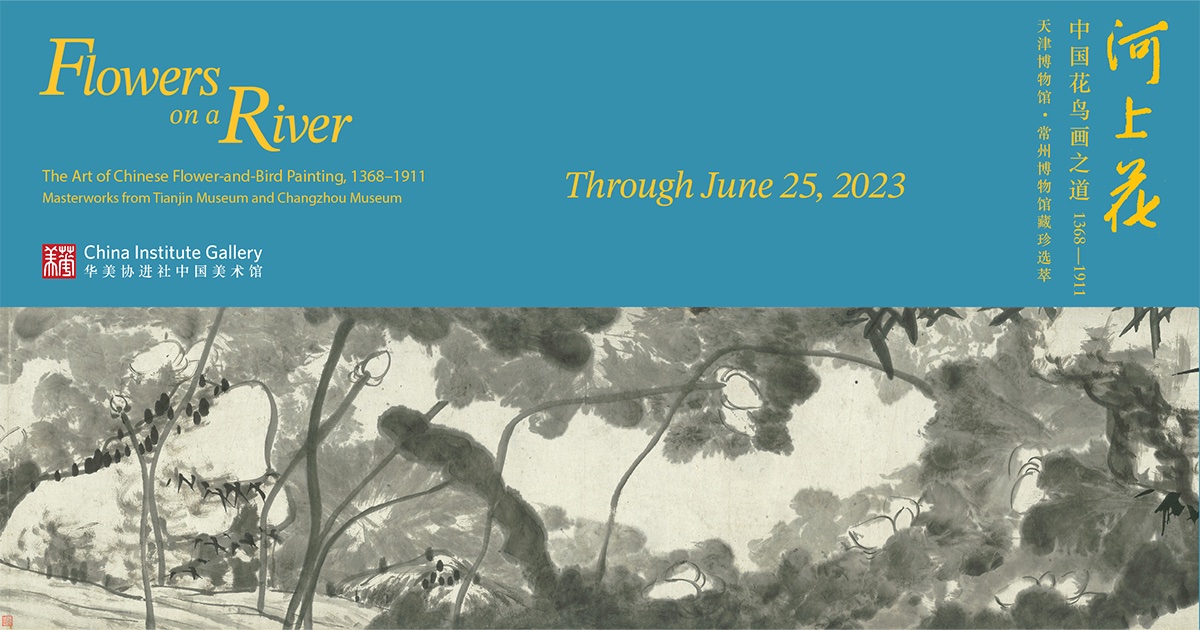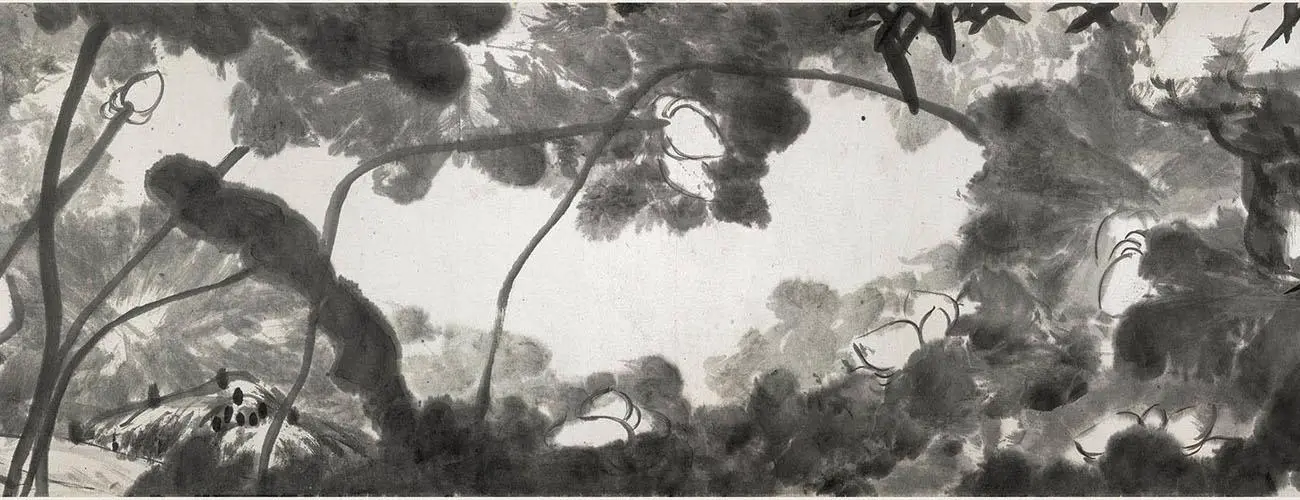

Zhu Da (1626 1705), Flowers on a River. 1697. Hand scroll; ink on paper, 19 x 508 7/8 in. (48.2 x 1292.5 cm). Collection of the Tianjin Museum (detail)
NEW YORK—China Institute Gallery—renowned for its thematic exhibitions of Chinese art and the only museum in the U.S. to exclusively show Chinese art—will reopen to the public on March 23, 2023, with a landmark exhibition of Chinese flower-and-bird paintings. The largest survey of its kind outside of China and the first in the U.S., Flowers on a River: The Art of Chinese Flower-and-Bird Painting, 1368-1911, Masterworks from Tianjin Museum and Changzhou Museum will showcase masterpieces of Chinese painting across five centuries. The exhibition will be on view through June 25, 2023. The exhibition marks the first showing of masterpieces traveling from China to the U.S. since the onset of the pandemic.
More than 100 masterworks by 59 artists will present some of the most important examples in the history of Chinese flower-and-bird painting. Spanning 500 years during the Ming and Qing dynasties, Flowers on a River will highlight the academic, literati, and individual styles of the artists. The Chinese concept of “humanity in harmony with nature” will be examined as well as the use of a special language of coded imagery to communicate meaning, which is central to Chinese art and culture. Flower-and-bird painting is one of three major genres of Chinese painting—alongside landscape and figure painting.
We are enormously excited for the reopening of China Institute Gallery and are honored to present some of Chinese art s greatest treasures. These exquisite depictions of flora and fauna provide an essential escape to the world of nature,”</em said Willow Weilan Hai, Lead Curator of the exhibition, Director and Chief Curator, China Institute Gallery. An exhibition of this extraordinary level would not have been possible without support from two of China s most prestigious museums. We are most grateful to the Tianjin Museum and the Changzhou Museum for their generous loans to the exhibition.”>
The exhibition will be accompanied by a richly illustrated bilingual catalogue featuring newly commissioned scholarly essays and detailed exhibition entries. A series of events are planned at China Institute Gallery including lectures, an international symposium, and other programs.
Flowers on a River is curated by Willow Weilan Hai, China Institute Gallery and guest co- curators Chen Zhuo, former Director of Tianjin Museum; Lin Jian, Director, Changzhou Museum; and David Ake Sensabaugh, former Ruth and Bruce Dayton Curator of Asian Art, Yale University Art Gallery; and organized by the China Institute Gallery, Tianjin Museum and Changzhou Museum.
Exhibition Overview
Flowers on a River will explore the natural world in the context of the human experience, revealing links that tie the genre’s imagery and the country’s everyday life and social customs. The exhibition will be presented in three parts: Precious Plums of the Palace: Academicism and Court Artists; Fragrant Plums in the Wild: The Literati Art, Painters and Painting Schools; and Vitality of Nature: Flower-and-Bird Painting and Social Customs.
The Ming and Qing periods saw the rise of women artists who excelled in flower-and-bird painting, and the exhibition includes the work of eight women artists, featuring scrolls by two of the most acclaimed, Ma Quan and Yun Bing. Born into families of artists during the Qing dynasty, they rose to prominence through the legacies of their fathers and grandfathers and were celebrated as “the two absolute talents.” Other women artists came from the “demimonde of the Qinhuai,” and were artistic courtesans, such as mid-Ming period artist Ma Shouzhen, also known as Ma Xianglan for her famous orchid paintings. A rare category of women artists made a living solely through art, such as Miao Jiahui who was as an art teacher and uncredited artist, providing her work for Empress Dowager Cixi to sign.
One of the highlights of the exhibition is the Qing dynasty hand scroll Flowers on a River, 1697, from which the exhibition takes its name. The 42-foot horizontal scroll by one of the greatest artists in Chinese history, Zhu Da (1626-1705), also commonly known as Bada Shanren, is considered a masterpiece of Chinese painting—last seen outside of China in the 2013 exhibition Masterpieces of Chinese Painting 700-1900 at the Victoria & Albert Museum in London.
A prince in the imperial Ming family, the enigmatic Bada Shanren went into hiding at a Buddhist temple and became a monk after the Manchu conquest of 1644. In 1680, he began a career as a working artist excelling in painting and calligraphy. His epic scroll Flowers on a River, painted when he was 72 years-old depicts the lifespan of a lotus flower from a seedling to blossoms— faded into a landscape, which holds many secret codes related to his life journey. As the master of individualism, both meditative and joyous, his free and loose brushwork anticipates abstraction by hundreds of years.
Bada Shanren pushed the expressive possibilities of monochrome ink and brush to the extreme, resulting in incredibly rich effects with an unmistakable individual character,” said Willow Weilan Hai. No one in the past has ever reached his level of achievement in this regard, and probably few after him will.”
The artists in Flowers on a River include: Lin Liang, Lü Ji, Shen Quan, Hu Mei, Yuan Jiang, Yuan Yao, Gao Qipei, Jiang Tingxi, Qian Weicheng, Miao Jiahui, Chen Lu, Chen Hongshou, Ma Shouzhen, Wen Zhengming, Tang Yin, Zhou Zhimian, Lu Zhi, Chen Chun, Wang Guxiang, Xu Wei, Xiang Shengmo, Zheng Xie, Jin Nong, Hua Yan, Li Shan, Huang Shen, Luo Pin, Gao Fenghan, Bian Shoumin, Shitao, Zhu Da, Yun Shouping, Tang Yuzhao, Ma Yuanyu, Ma Quan, Yun Bing, Yun Lanxi, Zou Yigui, Yun Guangye, Li Jue, Tang Shishu, Zhao Zhiqian, Pu Hua, Xugu, Ren Yi, Zhang Xiong, Wu Changshuo, Tang Luming, Zhu Cheng, Leng Mei, Chen Zun, Fan Qi, Wang Wu, Zhang Cining, Wang Caiping, Li Boyuan, Zhang Sheng, Sun Di, and Aisin-Gioro Yuying.
Flowers on a River will travel to the Santa Barbara Museum of Art, on view from October 15, 2023 to January 14, 2024.
Media Preview
A Media Preview will be held for Flowers on a River at China Institute Gallery on Tuesday, March 21, from 10 a.m. to 12 noon. Pre-registration is required. To RSVP, please contact Margery Newman at margerynewman@gmail.com.
Location and Hours
China Institute Gallery is located at 100 Washington Street at the corner of Washington Street and Rector Street in Lower Manhattan. Use the temporary entrance at 40 Rector Street to the 2nd floor.
Gallery hours are as follows:
Monday – Sunday 10 AM to 5 PM
Thursday: 10 AM to 8 PM
Closed on major holidays.
About China Institute
The nation’s oldest and most highly recognized educational institution devoted solely to Chinese culture, China Institute advances a deeper understanding of China through programs in education, culture, art, and business. With the belief that cross-cultural understanding strengths our global community, China Institute is the go-to resource on China—from ancient art to today’s business landscape and its rapidly shifting culture. The Institute’s programs, school, and gallery exhibitions bring to life the depth, complexity and dynamism of China. Programs, activities, courses, and seminars are offered on the visual and performing arts, culture, history, music, philosophy, language, and literature for the general public, children, and teachers, as well as for business. Founded in 1926 by Chinese reformers Hu Shi, K.P. Wen, and John Dewey, China Institute is the oldest bicultural, non-profit organization in America to focus exclusively on China.
About China Institute Gallery
China Institute Gallery is renowned for its intimate, first-class thematic exhibitions, which are accompanied by in-depth scholarly catalogues. Since 1966, the Gallery has presented over 100 exhibitions across all art forms including calligraphy, painting, ceramics, bronzes, jades, decorative art, folk art, architecture, photography, textiles, and contemporary art. Covering 5,000 years of Chinese history from the Neolithic period to present day, China Institute Gallery is the only non-commercial exhibition space solely dedicated to Chinese art in New York and the United States. The Gallery’s commitment to education through catalogues and art programming makes Chinese art available to audiences far beyond the Gallery’s doors. China Institute Gallery has collaborated with numerous Chinese museums. These exhibitions have showcased rarely seen collections from provincial and municipal museums in China, presenting cultural treasures as well as newly excavated artifacts to illuminate China’s rich cultural history. More information available online at: www.chinainstitute.org
Leadership gifts for Flowers on a River have been provided by the following: Henry Luce Foundation; Center for Language Education and Cooperation; LIU Dan and WANG Huiyun; and an anonymous donor. Additional support has been provided by: CHEN Chunyang; E. Rhodes and Leona B. Carpenter Foundation; Winnie C. and Michael Feng; The Shau-Wai and Marie Lam Family Foundation; Dame Jillian and Dr. Arthur M. Sackler Foundation for the Arts, Sciences and Humanities; James P. Geiss and Margaret Y. Hsu Foundation; Joseph Tse Foundation; Angela H. King; and Shining Sung. Flowers on a River is supported, in part, by public funds from the New York City Department of Cultural Affairs in partnership with the City Council. Flowers on a River is made possible by the New York State Council on the Arts with the support of the Office of the Governor and the New York State Legislature.
-###-
Press Contact:
Nicole Straus Public Relations
Nicole Straus, (917) 744-1040, nicole@nicolestrauspr.com
Kristin Guiter, (917) 635-1805, kristin@kristinguiter.com